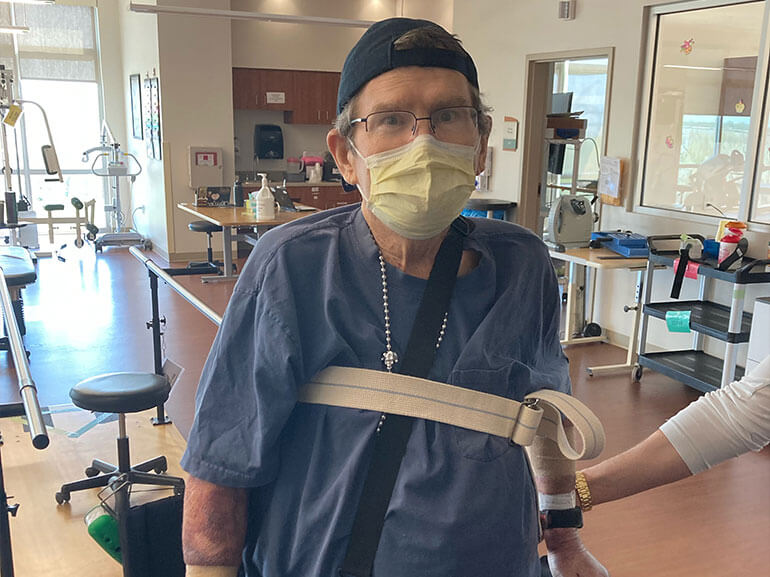Mike's Story

Air Force veteran Robert “Mike” Slade, 71, works as an ATM engineer and has a long history of heart failure. In 2012, he received a pacemaker, a device that restored the normal timing of his heartbeat and, for several years, appeared to have stabilized his heart condition.
Just shy of nine years after his pacemaker was placed, Mike was admitted to Gulfport Memorial Hospital with reoccurrence of symptoms consistent with heart failure and an echocardiogram ultrasound test was performed to evaluate his heart function. Mike’s heart ejection fraction, or an indication of how well the heart is pumping blood to the rest of the body, was determined to be only 10 percent. The average ejection fraction is between 55-70 percent.
Because of his advanced heart disease, Mike’s physicians recommended the placement of a left ventricular assist device (LVAD), a device that provides short- or long-term mechanical circulatory support for the heart. After his surgery, Mike endured a prolonged hospital stay due to numerous medical complications. The surgery and time in the hospital left Mike weakened and struggling with balance deficits and foot drop, or the inability to fully lift the foot, leading to his foot dragging while walking. Mike’s physicians felt that he could benefit from intensive rehabilitation and he was referred to Ochsner Rehabilitation Hospital.
During his initial therapy evaluations, Mike experienced dizziness when he stood or changed position and required increased time for all tasks due to his poor endurance. Mike’s physician-led team of nurses, physical, occupational and speech therapists devised a plan to steadily increase his activity tolerance and independence.
In physical therapy, Mike’s therapist guided him in a variety of exercises to improve his standing tolerance and balance, including reaching for cones and kicking a soccer ball. To improve his foot drop, Mike practiced toe taps to improve foot clearance and muscular strength as well as seated leg exercises to activate his muscles. Each day in therapy, Mike was able to increase the distance he could walk before requiring a rest break. Due to his left foot drop, physical therapists introduced the use of an ankle foot orthotic (AFO), a type of brace that increases foot clearance and improves the quality of walking and prevents falls.
Mike’s generalized muscle weakness left him suffering with dysphagia, or difficulty swallowing. Speech therapists conducted an instrumental swallowing assessment, called a modified barium swallow study, in which an x-ray video was taken while Mike swallowed various food and liquid textures. The swallow study revealed that when Mike drank liquids, a small amount of the liquid entered his airway instead of going down his esophagus. The swallow study also revealed that when Mike swallowed solid foods, there was a significant amount of residue in his throat, which later fell into his airway, putting him at even higher risk of aspiration pneumonia.
To prevent this, Mike was put on a modified diet of thickened liquids and soft solid foods and worked with his speech therapist to improve the strength of his swallowing muscles in order to tolerate a normal diet. The therapist guided Mike in swallowing exercises to target tongue base retraction and airway protection to keep food or liquid from entering the airway. Mike diligently completed his swallowing exercises both in and out of his speech therapy sessions.
Because Mike required assistance in using the bathroom and dressing his lower body, his occupational therapists focused on teaching him new strategies to perform activities of daily while also keeping his LVAD drive line safely intact. On top of this training, Mike’s occupational therapists worked diligently to improve his arm and hand strength and coordination by using therapy putty and other object manipulation tasks while he stood at a table to further increase standing endurance and balance.
Mike’s positive attitude and motivation enabled him to make amazing progress while at Ochsner Rehabilitation Hospital. By discharge, Mike was able to walk 110 feet with a rolling walker, stand up without assistance and navigate stairs with minor assistance to maintain balance. Because of his hard work and determination in speech therapy, Mike’s swallowing improved to the point where he could eat and drink normally again within the first few days in rehab. Mike also had become independent in his personal care, requiring minimal assistance to put on his shoes but able to do everything else with just stand by assistance.
In addition to his optimistic outlook, Mike said another influencing factor was how his therapy team kept pushing him, no matter how difficult it was. Mike says his daughter Angela also helped motivate him to reach his goals, sharing: “With good family support and hard work, anyone can accomplish their goals.”